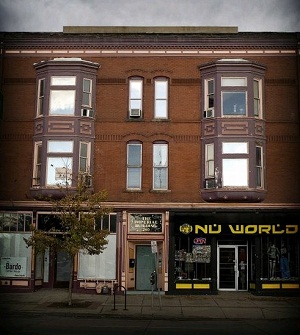A solar snapshot: The Imperial Building in Denver
 The owner of the Imperial Building, a small office building in Denver—where one Clean Energy Authority writer happens to hang out and drink coffee—is considering installing a 20 kilowatt (kW) photovoltaic (PV) array to capitalize on Denver’s average 300 sunny days a year. Over the past week, building owner Ron Tarver has talked with five installers about the costs and benefits of installing solar on this brick building built in 1891. Among the concerns he raised—beyond the price tag—were the impact on the roof—and the building, as well as the impact of wind and weather on the panels themselves.
The owner of the Imperial Building, a small office building in Denver—where one Clean Energy Authority writer happens to hang out and drink coffee—is considering installing a 20 kilowatt (kW) photovoltaic (PV) array to capitalize on Denver’s average 300 sunny days a year. Over the past week, building owner Ron Tarver has talked with five installers about the costs and benefits of installing solar on this brick building built in 1891. Among the concerns he raised—beyond the price tag—were the impact on the roof—and the building, as well as the impact of wind and weather on the panels themselves.
Tarver has looked at a variety of options now, and though he really wants to do solar, he said, “I’m still a Colorado boy. I don’t like to pull the trigger too quick.” He wants to make sure he gets the best array, deal, and incentive package from the installer he chooses. And with an upfront cost for a 20 kW system estimated at between $100,000 and $160,000—who can blame him.
Yesterday morning (Sept. 16), Chris Hamilton, a senior solar consultant with Denver-based Vibrant Solar, Inc. talked with Tarver about some options. Among the options he discussed was a 20 kW system using Trina Solar Ltd. modules. That system carried a ballpark price tag of $92,000 for the equipment, and $25,000 for installation. Such a system, according to Hamilton, is about 17 percent efficient at converting sunlight to electricity. The cost consisted of $68,000 in hardware costs and $52,000 in installation costs. That includes the $20,000 cost of two inverters to handle the power delivered by the PV installation, he said.
Hamilton also offered a ballpark bid for a system using Solyndra PV modules. Tarver said Hamilton’s ballpark estimate for a 22 kW Solyndra system would run around $150,000. Hamilton also said his company installs SunPower PV modules, which carry a $0.50 per watt premium over other panels. The added cost of the SunPower system is partly because its modules are more efficient than Trina modules.
Tarver was interested in the Solyndra modules, which are seeing a lot of adoption among warehouses, like the Budweiser brewery in Newark, New Jersey. Solyndra’s PV modules consist of thin tubes, wrapped with a PV-coating and arranged in a series, allowing wind to pass through them. Since other modules are flat plates, they could be affected by the wind. Solyndra modules are also designed to mount flat on a roof, with lightweight, non-roof penetrating mounting equipment.
Normally the rooftop on a building built in 1891, with a nearly flat roof, would need additional support to handle the weight of a two-and-a-half-ton PV system. However, the Imperial Building has a unique rooftop feature that should make installing solar on it much easier—a gigantic I-beam that traverses the length of the building it used to support two billboards. Architect Roger Day, whose office is in the building, has designed a support system for the PV array, capitalizing on the existing billboard mounts.
Tarver now is considering his options for the system, gathering data from the various installers’ preliminary bids and waiting for final bids before moving forward. He said he’s considered buying panels from China and installing them himself.
While this tale is far from over, it shows some of the concerns and realities smaller businesses and homeowners must face when considering solar. CEA will run a series as this project develops as one example of how the process really works.



